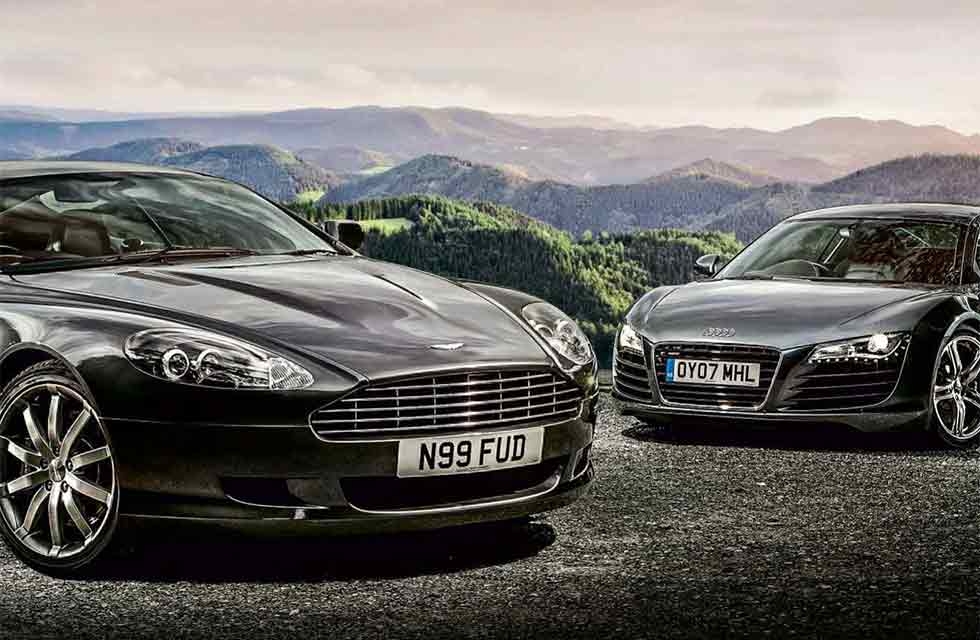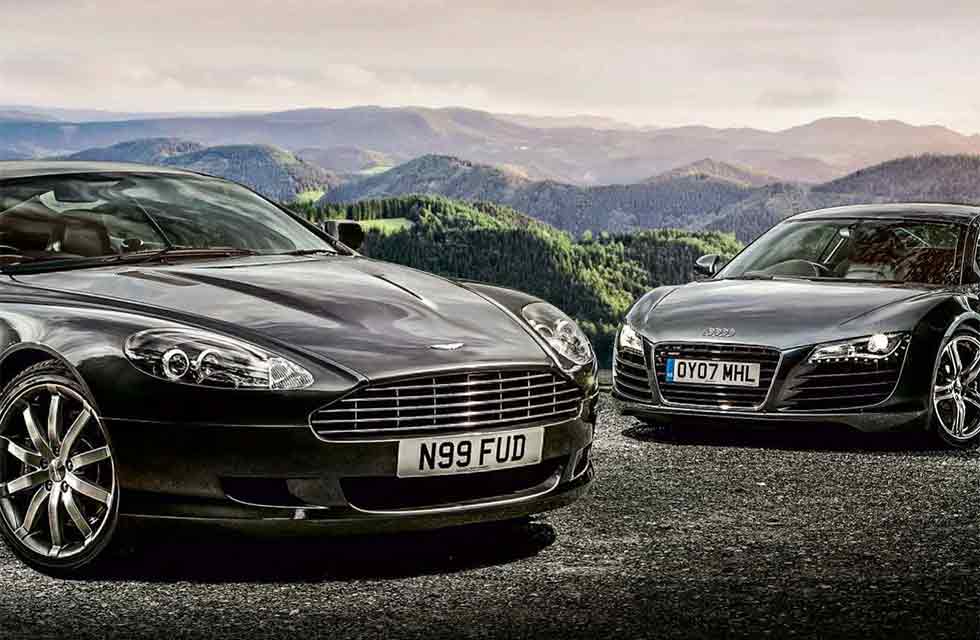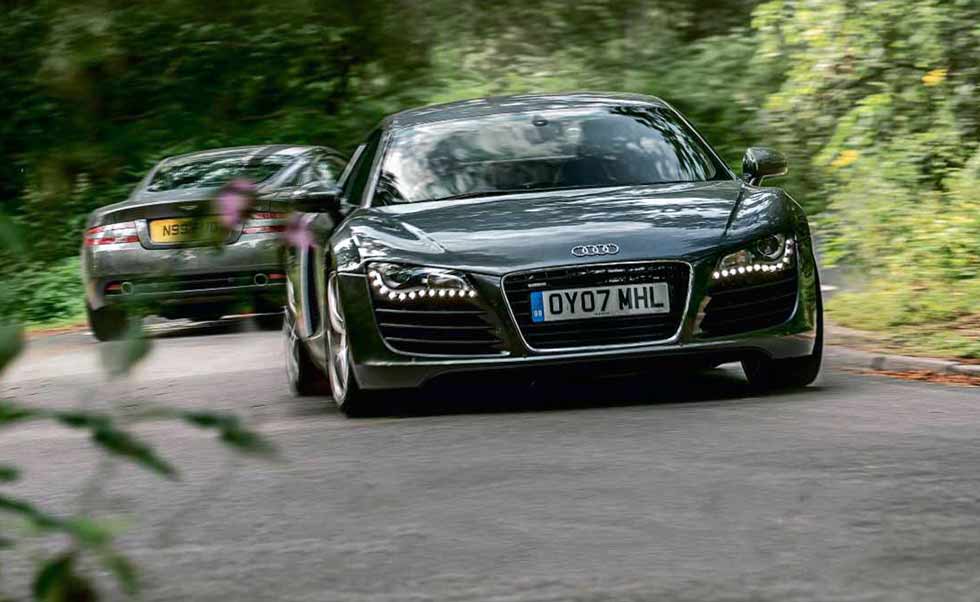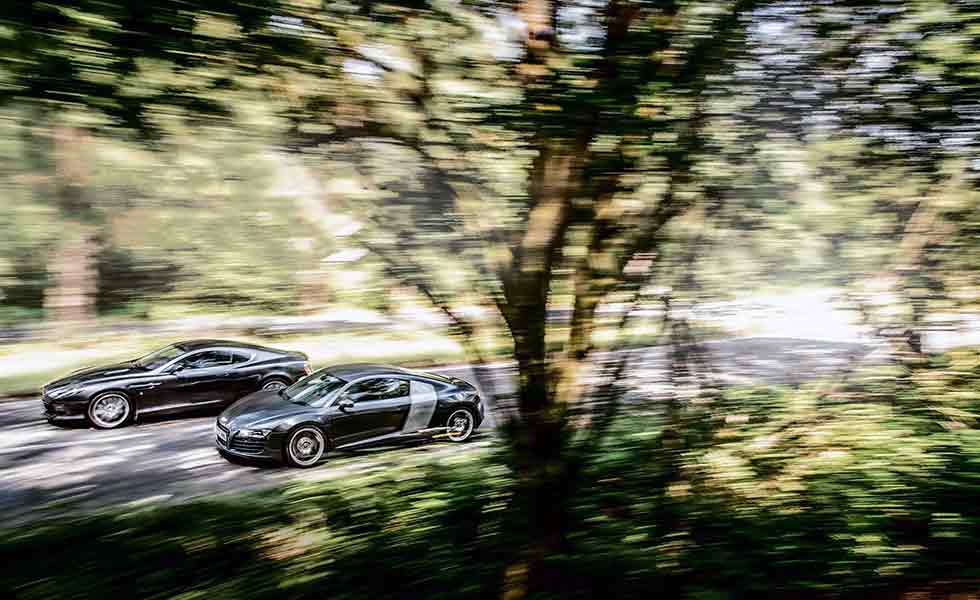
Bargain supercars: which is best? Plus Noughties performance cars to buy now. An epic Aston-Martin V12 Grand Tourer or Audi’s fire-breathing V8 mid engine supercar? Both are more affordable than you might think, and neither will be for long. John Simister agonises. Photography Charlie Magee.
THE A-LIST SELECTION BARGAIN SUPERCARS
Sensational Aston Martin DB9 and Audi R8, PLUS eight more post-millennial steals
Maybe these pages should be in monochrome. Our two cars are both painted in metallic grey, and the sun is so strong that colour seems almost bleached away as our eyes overload. Here at Octane, mostly we feature properly old cars in our major stories. Mostly. But such cars would lose some of their appeal on a day like today; occupants would burn or melt, engines might overheat, starting might become difficult as fuel vaporises in the wrong parts of the pipework. But for this tale we’re moving with time, comparing two blue-chip classics-in-waiting, noting that they are both well into their second decade and, currently, are temptingly affordable. Even better, serendipitous as it suddenly seems, both have first rate air-conditioning. Heated seats too, which is worth remembering as you may well be reading this in the cold.

They have modern electronics and fuelling, so they’ll work properly despite the heat – hold that thought; we’ll be returning to it. Also shared are chassis/body structures of aluminium, albeit very differently executed, and a six-speed Graziano transaxle. Engine outputs well beyond 400bhp, and the pace to match, are further common ground. On the face of it, either is an irresistible prospect. And their marque names both begin with A.
‘THE GEARLEVER CLACKED IN FERRARI FASHION THROUGH ITS OPEN GATE’
The Aston Martin DB9 came first, in 2004. The motoring world immediately gorged on its gorgeousness, but there was one obvious question. Aston Martin had already triggered its modern era with the Vanquish, styled by Ian Callum and visually, if not structurally, previewed by the Project Vantage concept car revealed in January 1998. The Vanquish was a sleek, muscular GT with much use of bonded and extruded aluminium in its structure and Aston’s Ford-derived V12 engine under its long bonnet. Exactly the same summary applied to the DB9. So, why the new car?

Because the DB9 was more modern, more thoroughly engineered for higher-volume production at Aston Martin’s new Gaydon factory, a better representation of what the new Aston generation should look like and feel like. And its structure, easily expanded or contracted, was to form the basis of a whole new Aston range. The Vanquish, Aston’s last car to be produced at Newport Pagnell, would continue for a while but the future was DB9-shaped, in myriad variations. However, we’d already seen a version of our other car, the 2006-launched Audi R8, before the DB9 arrived. We’d encountered the name, too, three Le Mans victories having been scored by sports-racing machines called Audi R8 by the time the Audi Le Mans Quattro concept car appeared in 2003. Two more had been added to the tally by the time that clearly very feasible concept car entered production in 2006, barely changed from three years earlier.
The DB9 was an obvious car for Aston Martin to create. A mid-engined supercar with an Audi badge was harder to grasp, not for any lack of motorsport pedigree (those Le Mans wins, World Rally Championship glory and the prewar Auto Unions had made the point) but because Audi was a mainstream producer of family transport. There was also the snag that, in the mid-Noughties, Audi’s reputation as a creator of roadgoing machinery to delight the keen driver was not the greatest, although the RS4 had shown that suitable talent did exist within Ingolstadt and Neckarsulm. Martin Winterkorn, nowadays most famous for complicity in the Dieselgate scandal but head of the whole Volkswagen Group at the R8’s launch, had the idea of creating the R8 while he was running the Audi division. The bones – figuratively and literally – of the idea already existed in the form of the Lamborghini Gallardo’s aluminium structure, which featured a unitary centre section with box-section extensions front and rear. Audi had developed this structure, using expertise it had gained from its aluminium A8, as the basis for Lamborghini’s first all-new model under the Volkswagen Group’s umbrella.

So using the structure for an Audi, and rendering it on brand by calling it (incorrectly) a ‘space frame’, was an expedient route to a potentially terrific image-builder. Among other things it could promote Audi’s ‘FSI’ direct-injection technology, employed to great effect in the RS4’s madly revving, addictively thrusting 4.2-litre V8: it was perfect for the R8. And given Audi’s long association with four-wheel drive, naturally the R8 would be thus equipped.
The DB9 was launched in the south of France, at a hotel whose gates opened directly on the fast, twisting road that leads to the Col de Vence. Ian Callum was gone from Aston Martin by then, engaged full-time with Jaguar, although he has since told the tale of how he and Wayne Burgess shaped the DB9 at Jaguar’s design centre at Whitley, Coventry.
‘STRAIGHT AWAY THIS CAR FEELS WEIGHTIER, BULKIER THAN THE R8’
Callum and Aston Martin’s then-boss, Dr Ulrich Bez, had a strained relationship. The mercurial Bez wanted Callum written out of the story so, at the launch, recent recruit Henrik Fisker, late of BMW’s California Designworks studio, was the design spokesman. He had redesigned the DB9’s tail-lights to incorporate the body-colour strip that bisects them, and he talked effusively about the way the sections of the side windows’ trim strips were invisibly welded together to give the appearance of a single solid piece of metal.
Politics notwithstanding, the DB9 was a fabulous-looking machine, more graceful than the broad-shouldered Vanquish, and I was itching to drive it. The test cars were all Touchtronic automatics, which used a conventional ZF torque-converter gearbox but programmed to give a definite throttle-blip when asked to downshift manually. It worked very nicely.

As did the whole car. Unlike the Vanquish, scuppered by the non-availability of suitably compact air-con components, the DB9’s interior followed the design philosophy revealed in Project Vantage in January 1998. So the centre console was smooth, rounded but crisply detailed, the instruments had a machined-metal 3D-look to their calibrations, everything was authentic in that no material tried to look like something it wasn’t. Metal was metal, glass was glass (including the etched ashtray), leather was leather. There was satin-finish wood, too, designed to ‘age gracefully’.
The DB9 gobbled those mountain roads, its responses the sort that spirited its bulk away, and its engine was the same temple to torque and power that it had been in the Vanquish and DB7 Vantage before it. Bumps were flattened, dips filled in; dynamically the DB9 was a triumph.
Except that on the autoroute, returning to base, it died and we had to pull smartly onto the hard shoulder. A lack of fuel pressure, it was later discovered, caused shutdown to prevent piston damage from an over-weak mixture. At least it restarted and we were able to stagger back by keeping the revs down and the loads low.
Then the production-specification cars got the road-test treatment, and the dynamic magic had deserted the DB9. How? What happened? The launch cars had adjustable development dampers, whose careful calibration hadn’t been replicated for the production cars in the way Aston intended. There was work to be done.
‘THE AUDI R8 IS THE MORE THRILLING TO DRIVE ITS CONTROLS MORE PRECISELY HONED‘
Audi launched the R8 in Las Vegas. The test route took us, via a speed-related interlude with a traffic cop whose friendliness proved quite a relief (hell, we’d only been doing 85), to Death Valley and a cheeseburger in Furnace Creek, in summer one of planet Earth’s hottest spots. It was February 2007, but even in February the air-con was working hard.
Here, we were discovering, was an Audi unlike any other apart from the familiar fireworks of its RS4 engine. It felt like, well, a Lamborghini, precise and pointable in the best mid-engined way, but with sudden power-induced tailslides instantly calmed as torque headed towards the front wheels. It felt foolproof without suggesting its driver might be foolish. The lever for its manual gearbox clacked in Ferrari fashion through its Ferrari-like open gate, adding a touch of theatre as the R8 was set-up to snick through another bend. I was having a viscerally great time, the sensations not quite computing with the view of the four rings on the steering wheel and the cabin’s obvious Audiness. Some mental recalibration was required here.
But I wasn’t so keen on the snatchy, and optional, carbon-ceramic brakes, nor on the surge-prone progress of the R-tronic version I drove later. That used the same mechanically manual transaxle but with clutch and gearshift controlled automatically. No double-clutcher for the R8, yet.
A dozen years later, I’m gazing at the 2007 R8 from Audi UK’s heritage fleet – a manual ex-press fleet car, now 54,000 miles travelled – that has just arrived on my driveway. Has it really been that long?
The design could be new if only it had a few more sharp edges, like today’s Audis (V10-powered, second-generation R8 included) have. You could take a mid-period Audi TT, widen it and flatten it and move the cab forward, but you would still be some way away from the look of an R8. You’d need to add giant air intakes at the front and giant air outlets at the back, all traversed by black strakes. And slice the flanks to lead into air intakes just behind the doors, bounded by contrasting ‘blades’ heading right up to the roof.
It’s these blades that make an R8 look like nothing else, that make it memorable in a sea of mid-engined supercars from makers large and small (for a supercar, architecturally at least, is what the R8 is). The cabin has that effect, too, but for a different reason: in relative terms, it’s almost normal.
That’s because it has reassuringly familiar Audi switchgear and graphics, Audi textures, Audi quality… but also some of the hard plastics of a volume-produced car, and several pieces of what looks like polished aluminium but isn’t. None of this actually matters, but it brings you down to earth. At least, it does until you start the engine (via a normal key), slide-clack the R8 into gear and rocket away to the tight, disciplined but very vocal beat of that crackling-crisp V8. Once the fluids have warmed through I can discover anew the way that this engine just revs and revs like an automotive lemming. Peak power (420bhp) arrives at 7800rpm to the sound of a savage, ultra-rapid series of staccato exhaust pulses, the limiter at 8250rpm. So speedily does this engine sear through the gear ratios that you wonder where they’ve all gone, even though there are six of them.
All the while, what was the fleeting vista ahead streaks under the low nose and past the underfloor downforce ducts as you relish the way you can see so much while sitting so low. The measured, precise steering adds to the intimacy, of your one-ness with your R8, especially as speed rises. When you need to slow back down, this car’s standard cast-iron brake discs give a potent sense of energy absorption and a progressiveness of response such that you really wouldn’t want those carbon-ceramics.
You feel you can drive anywhere, that no road is off-limits to the Audi with its sense of tight, controlled, well-oiled motion. I remember once taking one through narrow, bumpy lanes on a traffic-busting route home, and it was just fine. I wouldn’t have attempted that in a Ferrari although I would have done in a 911, the R8’s closest market rival back then. Here is the supercar in its most usable form; it even has a decent boot up front. But maybe, for all that usability, you still favour a more ‘normal’ car, perhaps even with compact rear seats. A DB9, for example.
Ian black did, and bought his 2006 example five years ago. He wanted a rare manual, as we did for the purposes of comparison in this story, and it proved hard to find. ‘There were only three available,’ he says, ‘a black one in the north, a grey one in Wales but it had a lime green interior, and this one from Grange Aston Martin in Essex.’ Good choice; to my eyes this metallic grey (‘Meteorite Silver’) paintwork with dark red (‘Wildberry’) interior is the best DB9 colour combination of all.
Before this car I’ve driven only one manual DB9. It was fitted with the sport suspension pack, later deleted when the range got adaptive dampers, and it was not nice at all, with a fidgety, thumpy ride, lots of road roar and a feeling of a great car ruined. Its manual transmission was tetchy, too, in that co-ordinating a narrow bite-band clutch and a hard-to-modulate throttle made gentle driving far harder than it should have been.
Ian’s car is a whole lot nicer. Some of that pedal co-ordination trouble remains until you learn the required technique – the Audi has it, too, to a lesser degree – and that might be one reason why the Aston’s excellent automatic alternative is so much more popular. It took years, and a new management system used first in the V12 Vantage S, before the V12 engine and a manual gearbox co-existed truly happily, but this DB9 and I seem to be getting on just fine as we head away from clogged Surrey towards rural Hampshire.
Straight away this feels a weightier, bulkier car than the R8, albeit not as back-road-intimidatingly wide as today’s DB11. The scuttle is higher, obviously, and it falls more heavily into bits of missing road surface. The mileage is lower – not quite 37,000 – but it doesn’t feel that way. Perhaps the greater weight gives the suspension joints a harder time, although at speed on smoother roads it’s clear that the damper settings had been properly sorted out by the time this car was built.
Neither does the gearchange feel as precise, even though it’s the same gearbox type and in theory the linkage is more direct. Maybe there’s more to the R8’s exposed gate than mere showing-off. The sense in the DB9 is of a grand tourer with a sporting edge buried a little below the surface; the R8 inverts that sense by being an overt sports car able to civilise itself if you really insist.
What the DB9 does have is an engine of mighty presence when roused, as you would expect from 5.9 litres (it boasts ‘6.0’ between the inlet manifolds), 450bhp and a peaktorque advantage of just over 100lb ft. You start it with a button in the middle of the centre console, upon which the engine gives a rev-whap and settles to the busy idle of 12 cylinders on action standby. And then we’re off through the gears, engine blaring beatlessly and keenly, the Aston taut and planted on the road just as its sibling was on the road to the Col de Vence.
In traffic, negotiating road clutter and reined in by low limits, the DB9 feels a touch clumsy after the R8 but it all comes right once the roads open up. And then there’s the way it looks; it’s surely one of the most beautiful cars to come out of a decade when the art of automotive beauty was under threat, albeit not as much as it is now.
The Aston is sleek, unadorned, understated, and the air of precision and quality sensed in 2004 has kept its promise in 2019. The wood has aged, just as Fisker said it would, but that just makes the DB9 more real, more of a nascent classic. The Linn sound system, a bold and unusual fitment, still works well too; it’s from Scotland, which pleases its owner who is similarly Scottish.
We’re taking photographs of the engine bays, in which the cars’ aluminium bones – lots of bonding and extrusions in the Aston – are both seen and celebrated. In fact you don’t need to raise the cover of the Audi, because the engine is on proud display right under the rear window. You could even specify LEDs to illuminate it should you stumble by mistake into the Chelsea Cruise, a technology also available – in an industry first – for the headlights.
And then it’s time to head home, and guess what: the Audi’s engine dies, probably through heat-related electronic trauma or fuel vaporisation. Naturally I think back to the DB9 launch: is this karma? But with that score evened out, I must choose a winner. For the name alone, the Aston Martin DB9 is the more enticing, and it’s also more affordable with prices starting just beyond £30,000. Audi R8s start at just under £40,000; entry-level ones are newer than the lowest-cost Astons, of course, and year-for-year the two cars’ values are similar.
So, would I have the DB9? The problem is that the Audi is the more thrilling drive, its controls are more precisely honed, it rides better and it feels wieldier in a tight spot. Driving it is, simply, more fun. But I do wonder if I might enjoy owning the Aston more, dealing with enthusiastic specialists, maybe joining the AMOC. Another problem is one of philosophy: I instinctively prefer manuals, but unlike the Audi the Aston works better as an automatic.
It’s the Audi R8 for me, I think. But if you disagree, I’m with you all the way.
For more performance car bargains, turn the page. Octane’s markets editor Matthew Hayward has been very busy indeed… Above, below and right Four rings on the steering wheel of a supercar came as a shock; manual transmission is increasingly a thing of the past at this level; Audi is strikingly handsome – but DB9 is gorgeous. Right and left Simister enjoys the thrill of the precise and rapid R8, yet the DB9 is certainly brawny enough to stay ahead; Audi’s V8 clearly – and proudly – visible under glass cover.
Above, right and below Mid-engined R8 plays front-engined DB9; Aston interior was modern at launch, and its materials have mellowed beautifully with age; more power, torque and cylinders in DB9’s V12.
2006 Aston Martin DB9
Engine 5935cc 60º V12, aluminium block and heads, DOHC per bank, 48-valve, electronic fuel injection and management
Max Power 450bhp @ 6000rpm
Max Torque 420lb ft @ 5000rpm
Transmission Six-speed manual transaxle, rear-wheel drive
Steering Rack and pinion, power-assisted
Suspension Front and rear: double wishbones, coil springs, telescopic dampers, anti-roll bar
Brakes Vented discs
Weight 1710kg
Top speed 186mph
0-60mph 4.7sec
2007 Audi R8
Engine 4163cc mid-mounted, 90º V8, aluminium block and heads, DOHC per bank, 32-valve, electronic direct fuel injection and management
Max Power 420bhp @ 7800rpm
Max Torque 317lb ft @ 4500-6000rpm
Steering Rack and pinion, power-assisted
Transmission Six-speed manual transaxle, four-wheel drive
Suspension Front and rear: double wishbones, coil springs, telescopic dampers, anti-roll bar
Brakes Vented discs
Weight 1560kg
Top speed 186mph
0-60mph 4.5sec





